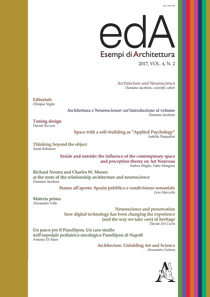Estratto da
ESEMPI DI ARCHITETTURA
International Journal of Architecture and Engineering
Inside and Outside: the Influence of the Contemporary Space and Perception Theory on Art Nouveau
ESEMPI DI ARCHITETTURA
International Journal of Architecture and Engineering
Inside and Outside: the Influence of the Contemporary Space and Perception Theory on Art Nouveau

It is well-known the debt of the Art Nouveau movement with the esthetical theory of late eighteenth Century Central European culture, and specially with the Viennese school: it’s not by chance that the theoretical construct of Kunstwollen, developed by Alois Riegl, has been often connected to Van de Velde’s or to the first Peter Behrens’ work, while that of Einfühlung has been connected with the Belgian Art Nouveau. It hasn’t been tried any historiographical investigation to understand if and how the new, “fluid” Art Nouveau spatiality, as well as the new relationship between inner and outer space, owe something to that school of thought, which had previously concentrated the architectural interpretation both on the perception and on the notion of space. Since the Seventies up to the Nineties of nineteenth Century a great number of studies, most of all in German language (such as those of Robert Vischer, Rudolf Adamy, Adolf Göller, Adolf von Hildebrand, Konrad Fiedler, Theodor Lipps, August Schmarsow, Heinrich Wölfflin), contributes to develop a new idea of space, which from many points of view takes form in the contemporary and later works of Jugendstil and Secession or, in general, of Art Nouveau
| pagine: | 37-44 |
| DOI: | 10.4399/97888255087276 |
| data pubblicazione: | Dicembre 2017 |
| editore: | Aracne |








